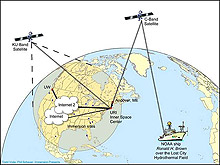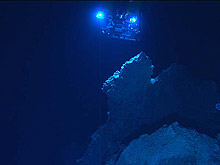
Diagram showing how video and data will be transmitted between the NOAA ship Ronald H. Brown, via satellite and Internet 2, to the Inner Space Center at URI, the University of Washington, and other participating sites. Click image for larger view and image credit. (HR)
Space shot to our own planet: ROV Hercules approaches a ghostly, white, carbonate spire in the Lost City Hydrothermal Field, about 2500 feet below the surface of the Atlantic Ocean. Click image for larger view and image credit.
The Lost City 2005
July 17 - August 4, 2005
![]() Hercules Explores Lost City (Quicktime, 824 Kb)
Hercules Explores Lost City (Quicktime, 824 Kb)
![]() Aurelia Jelly Fish undulates several meters above the seafloor (Quicktime, 720 Kb)
Aurelia Jelly Fish undulates several meters above the seafloor (Quicktime, 720 Kb)
![]() Beehive (Quicktime, 996 Kb)
Beehive (Quicktime, 996 Kb)
![]() Nature Tower (Quicktime, 1 Mb)
Nature Tower (Quicktime, 1 Mb)
![]() 12 meter chimney (Quicktime, 768 Kb)
12 meter chimney (Quicktime, 768 Kb)
Live pictures of the white chimneys of Lost City will travel from 2,100 feet below sealevel to the NOAA ship Ronald H. Brown, across the Atlantic Ocean to the University of Rhode Island and then across the USA to scientists at University of Washington in Seattle. In less than 2 seconds live video will have traveled over 5,000 miles. With new technology, many scientists and students will be able to view and analyze data without being on a ship at sea. It is the introduction of a new methodology for marine fieldwork. On this expedition our underwater cameras will explore Lost City.
In 2000 a remarkable discovery occurred. Cruising over a large mountain west of the Mid-Atlantic Ridge scientists using underwater cameras sighted strange 90 to 200 foot white towers. This was the discovery of a completely new kind of underwater hot spring environment unlike any seen before. We now call these springs the Lost City Hydrothermal Field (LCHF). This expedition will explore LCHF 24-hours a day for 10 days using IFE's Remotely Operated Vehicles (ROV's) Argus and Hercules and immediately transmitting that data to scientists on-shore.
Expedition updates from Immersion Presents:
Expedition updates from Jason:
What's this?
Both Jason ![]() and Immersion Presents
and Immersion Presents ![]() are covering various aspects of this expedition. We are using
Really Simple Syndicatioin (RSS) to keep you informed of the latest news from these Web
sites. By following the links above, you will be leaving the U.S. Government's NOAA Ocean Explorer Web site.
are covering various aspects of this expedition. We are using
Really Simple Syndicatioin (RSS) to keep you informed of the latest news from these Web
sites. By following the links above, you will be leaving the U.S. Government's NOAA Ocean Explorer Web site.
You can access the NOAA, Ocean Explorer Lost City 2005 News feed here: ![]()
Updates & Logs
Click images or links below for detailed mission logs.
 Mission Summary This 2005 expedition set
a new benchmark in ocean exploration. Remarkable advances in technology allowed,
for the first time, participation of an entire science party housed not on
a research vessel, but instead in a Science Command Center located 4500 miles
away.
Mission Summary This 2005 expedition set
a new benchmark in ocean exploration. Remarkable advances in technology allowed,
for the first time, participation of an entire science party housed not on
a research vessel, but instead in a Science Command Center located 4500 miles
away. July 31, 2005 As the ship prepares to leave the work
site today, we again revisit some of the main, actively
venting chimneys within the Lost City field.
July 31, 2005 As the ship prepares to leave the work
site today, we again revisit some of the main, actively
venting chimneys within the Lost City field.  July 30, 2005 As we near the end of the cruise, we
realize what remarkable views of the field the coupling of Hercules and "the
eye in the sky" Argus has provided us.
July 30, 2005 As we near the end of the cruise, we
realize what remarkable views of the field the coupling of Hercules and "the
eye in the sky" Argus has provided us.  July 29, 2005 If
you lost something in an area of 645,000 square feet how would you
find it? Find out how scientists are
searching for a missing water sampler.
July 29, 2005 If
you lost something in an area of 645,000 square feet how would you
find it? Find out how scientists are
searching for a missing water sampler. July 28, 2005
July 28, 2005  July 27, 2005 As
we explore the Lost City, we want to
learn if the animals at Lost City are unique and if the composition
of the animals' communities is driven by the harsh chemical conditions
of the Lost City habitats.
July 27, 2005 As
we explore the Lost City, we want to
learn if the animals at Lost City are unique and if the composition
of the animals' communities is driven by the harsh chemical conditions
of the Lost City habitats.  July 26, 2005
July 26, 2005  July 25, 2005
July 25, 2005  July 24 PM, 2005
July 24 PM, 2005  July 24 AM, 2005
July 24 AM, 2005  July 23, 2005 The Ronald H. Brown arrived
at the first study site. The first order of business was collect new bathymetric data of the dome-like
mountain, referred to as the Western Massif.
July 23, 2005 The Ronald H. Brown arrived
at the first study site. The first order of business was collect new bathymetric data of the dome-like
mountain, referred to as the Western Massif.  July 22, 2005 The first exploration dive is planned
for tomorrow. As the Ronald H.
Brown cruises towards
the Mid-Atlantic Ridge, technicians
and scientists prepare for the first dive.
July 22, 2005 The first exploration dive is planned
for tomorrow. As the Ronald H.
Brown cruises towards
the Mid-Atlantic Ridge, technicians
and scientists prepare for the first dive.
 July 21, 2005 Today the team, our team of scientists,
began to gather at the University of Washington. Get
acquainted with them as they describe their hopes and goals for this expedition.
July 21, 2005 Today the team, our team of scientists,
began to gather at the University of Washington. Get
acquainted with them as they describe their hopes and goals for this expedition. July 17, 2005 Follow
our journey as NOAA's ship The Ronald H. Brown heads to the Mid-Atlantic
Ridge to explore the white chimneys of the hydrothermal vent
field known as Lost City.
July 17, 2005 Follow
our journey as NOAA's ship The Ronald H. Brown heads to the Mid-Atlantic
Ridge to explore the white chimneys of the hydrothermal vent
field known as Lost City. 


























